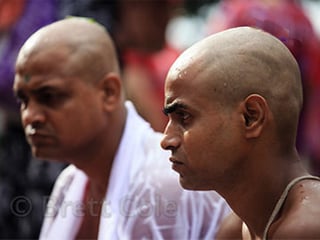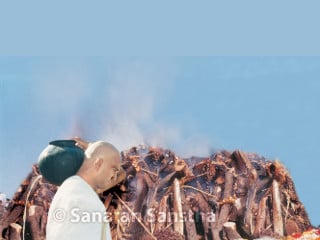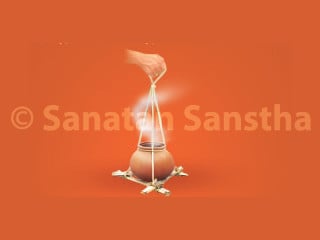If post-death rites are performed with faith and as prescribed by our Scriptures, then the linga-dēha (subtle body) of the deceased person, without getting trapped in Bhulok (Earth region) or Martyalok (In the region of the dead), acquires a positive momentum and moves on to higher regions. Consequently, the possibility of the deceased person tormenting the family members reduces. The possibility of such a linga-dēha being enslaved by negative energies reduces too.
In the following article it is explained why male family members of a deceased should shave off their heads, while the female family members should not.
When a family member passes away, the environment in the house becomes Raja-Tama predominant. The linga-dēha of the deceased keeps wandering around the house or around the family members for some time. The speedy Raja-Tama predominant waves emitting from the linga-dēha of the deceased get attracted to the black colour of the hair of the family members. One function of the hair is to absorb the Raja-Tama predominant waves from the environment. Absorption of such waves can result in distress such as severe headache, numbness of head, feeling of uneasiness, etc. to the family members. Men who actively participate in the final rites have higher chances of suffering from such distress. To avoid this suffering, they must shave off their heads completely.
Question : In the previous paragraph it is said that, ‘The Raja-Tama predominant waves emitting from the linga-dēha of the deceased, traveling at a high speed get attracted to the black colour of the hair of their family members’. At the same time, as per spiritual science, it is also true that ‘to a certain extent, hair provide protection from negative energy attacks’. How to strike a balance between the two statements ?
Answer : If the percentage of Raja-Tama component in the environment exceeds 50, then an individual can suffer from distress due to negative energies. Hence, protection of an individual from negative energies due to his hair is to a limited extent only.
Hindu Dharma considers woman to be a symbol of the unmanifest Shaktī (Divine Energy) of Adishaktī (Primal Energy). It is for this reason that Hindu Dharma bestows the woman a position of high respect. Having long hair is a symbol of modesty and therefore, cutting of hair by women is an anti-Dharmik act. A woman with a Sattva predominant disposition usually has long hair. The energy oriented Sattva-Raja waves transmitted by the tips of the hair, in a way, protect a woman from negative energy attacks. Hence, cutting of hair by women is generally prohibited or considered inauspicious. Conversely, ‘man’ is a symbol of active Shaktī and hence, whenever a family member passes away, the responsibility of all the final rites falls on the shoulders of male members of the family; hence, males shave off their heads completely.
Reference : Sanatan’s Holy Text, ‘Death and post-death rites’


 Rituals to be performed prior to and during cremation of a dead body
Rituals to be performed prior to and during cremation of a dead body Rituals to be performed after cremation till the 13th day after death
Rituals to be performed after cremation till the 13th day after death In which direction should the dead body be placed before taking it to the crematorium ?
In which direction should the dead body be placed before taking it to the crematorium ? Rituals after death as per Hinduism
Rituals after death as per Hinduism